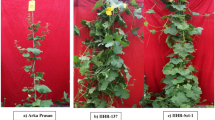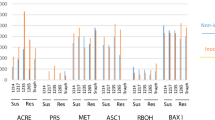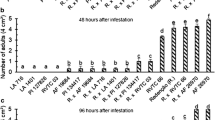Summary
The Alternaria stem canker resistance locus (Asc-locus), involved in resistance to the fungal pathogen Alternaria alternata f. sp. lycopersici and in insensitivity to host-specific toxins (AAL-toxins) produced by the pathogen, was genetically mapped on the tomato genome. Susceptibility and resistance were assayed by testing a segregating F2 population for sensitivity to AAL-toxins in leaf bioassays. Linkage was observed to phenotypic markers solanifolium and sunny, both on chromosome 3. For the Asc-locus, a distance of 18 centiMorgan to solanifolium was calculated, corresponding to position 93 on chromosome 3. This map position of the resistance locus turned out to be the same in three different resistant tomato accessions, one Dutch and two American, that are at least 40 years apart. AAL-toxin sensitivity in susceptible and resistant tomato genotypes was compared with AAL-toxin sensitivity in a non-host Nicotiana tabacum during different levels of plant cell development. In susceptible and resistant tomato genotypes, inhibitory effects were demonstrated at all levels, except for leaves of resistant genotypes. However, during pollen and root development, inhibitory effects on susceptible genotypes were larger than on resistant genotypes. In the non-host Nicotiana tabacum, hardly any effects of AAL-toxins were demonstrated. Apparently, a cellular target site is present in tomato, but not in Nicotiana tabacum. It was concluded that three levels of AAL-toxin sensitivity exist: (1) a susceptible host sensitivity, (2) a resistant host sensitivity, (3) a non-host sensitivity, and that the resistance mechanism operating in tomato is different from that operating in Nicotiana tabacum.
Similar content being viewed by others
References
Bino RJ, Franken J, Witsenboer HMA, Hille J, Dons JJM (1988) Effects of Alternaria alternata f. sp. lycopersici toxins on pollen. Theor Appl Genet 76:204–208
Clouse SD, Gilchrist DG (1987) Interaction of the asc locus in F8 paired lines of tomato with Alternaria alternata f. sp. lycopersici and AAL-toxin. Phytopathology 77:80–82
Dixon LK, Leaver CJ, Bretell RIS, Gengenbach BG (1982) Mitochondrial sensitivity to Drechslera maydis T-toxin and the synthesis of a variant mitochondrial polypeptide in plant derived from Maize tissue cultures with Texas Male Sterile Cytoplasm. Theor Appl Genet 63:75–80
Doremus HD, Jagendorf AT (1985) Subcellular localization of the pathway of the de novo pyrimidine nucleotide biosynthesis in pea leaves. Plant Physiol 79:856–861
Elliston J, Kuc J, Williams EB (1977) Effect of heat treatment on the resistance of Phaseolus vulgaris to Colletotrichum lindemuthianum and Colletotrichum lagenarium. Phytopath Z 88:43–52
Ferguson AR, Johnston JS (1980) Phaseolotoxin: Chlorosis, ornithine accumulation and inhibition of carbamoyltransferase in different plants. Physiol Plant Pathol 16:269–275
Gilchrist DG (1983) Molecular modes of action. In: Daly JM, Deverall BJ (eds) Toxins and plant pathogenesis. Academic Press, Sydney, pp 81–136
Gilchrist DG, Grogan RG (1976) Production and nature of a host-specific toxin from Alternaria alternata f. sp. lycopersici. Phytopathology 66:165–171
Grogan RG, Kimble KA, Misaghi I (1975) A stem canker disease caused by Alternaria alternata f. sp. lycopersici. Phytopathology 65:880–886
Haldane JBS (1919) Cited in: Redei GP (ed) Genetics (1982) Macmillan, New York J Genet 8:291
Heath MC (1980) Reactions of nonsuscepts to fungal pathogens. Annu Rev Phytopathol 18:211–236
Kao KN and Michayluk MR (1975) Nutritional requirement for growth of Vicia hajastana cells and protoplasts at a very low population density in liquid media. Planta 126:105–110
Kohmoto K, Verma VS, Nishimura S, Tagami M, Scheffer RP (1982) New outbreak of Alternaria Stem Canker of Tomato in Japan and production of host-selective toxins by the causal fungus. J Fac Agric Tottori Univ 17:1–8
Koornneef M, Hanhart CJ, Martinelli L (1987) A genetic analysis of cell culture traits in tomato. Theor Appl Genet 74:633–641
Lazarovits G, Higgins VJ (1976a) Histological comparison of Cladosporium fulvum race 1 on immune, resistant and susceptible tomato varieties. Can J Bot 54:224–234
Lazarovits G, Higgins VJ (1976b) Ultrastructure of susceptible, resistant and immune reactions of tomato to races of Cladosporium fulvum. Can J Bot 54:235–249
Maliga P, Breznovits A, Marion L (1973) Streptomycin-resistant plants from callus of resistant tobacco. Nature 24:29–30
Mitchell RE (1976) Isolation and structure of a chlorosis-inducing toxin of Pseudomonas phaseolicola. Phytochemistry 15:1941–1947
Murashige T, Skoog F (1962) A revised medium for rapid growth and bioassays with tobacco tissue cultures. Physiol Plant 15:97–104
Negrutiu I, Shillito R, Potrykus I, Biasini G, Sala F (1987) Hybrid genes in the analysis of transformation conditions. I: Setting up a simple method for direct gene transfer in plant protoplasts. Plant Mol Biol 8:363–373
Park P, Nishimura S, Kohmoto K, Otani H (1981) Comparative effects of host-specific toxins from four pathotypes of Alternaria alternata on the ultrastructure of host cells. Ann Phytopathol Soc Jpn 47:488–500
Shibita H, Ochiai H, Sawa Y, Miyoshi S (1986) Localization of carbamoylphosphate synthetase and aspartate carbamoyltransferase in chloroplasts. Plant Physiol 80:126
Shibita H, Sawa Y, Ochiai H, Kawasima T, Yamane K (1987) A possible regulation of carbamoylphosphate synthetase and aspartate carbamoyltransferase in chloroplasts. Plant Sci 51:129–133
Shillito RD, Paszkowski J, Potrykus I (1983) Agarose plating and bead-type culture technique enable and stimulate development of protoplast-derived colonies in a number of plant species. Plant Cell Rep 2:244–247
Siler DJ, Gilchrist DG (1983) Properties of host-specific toxins produced by Alternaria alternata f. sp. lycopersici in culture and in tomato plants. Physiol Plant Pathol 23:265–274
Steele JA, Uchytil TF, Durbin RD, Bhatnagar P, Rich DH (1976) Chloroplast coupling factor. 1: A species-specific receptor for tentoxin. Proc Natl Acad Sci USA 73, 7:2245–2248
Suiter KA, Wendel JF, Case JS (1987) Linkage-1: a PASCAL Computer program for the detection and analysis of genetic linkage. J Hered 74:203–204
Turner JG (1981) Tabtoxin, produced by Pseudomonas tabaci, decreases Nicotiana tabacum glutamine synthetase in vivo and causes accumulation of ammonia. Physiol Plant Pathol 19:57–67
Turner JG (1986) Activities of ribulose-1,5-biphosphate carboxylase and glutamine synthetase in isolated mesophyll cells exposed to tabtoxin. Physiol Mol Plant Pathol 29:59–68
Witsenboer HMA, Schaik CE van, Bino RJ, Löffler HJM, Nijkamp HJJ, Hille J (1988) Effects of Alternaria alternata f. sp. lycopersici toxins at different levels of tomato plant cell development. Plant Sci 56:253–260
Author information
Authors and Affiliations
Additional information
Communicated by G. Wenzel
Rights and permissions
About this article
Cite this article
Witsenboer, H.M.A., van de Griend, E.G., Tiersma, J.B. et al. Tomato resistance to Alternaria stem canker: localization in host genotypes and functional expression compared to non-host resistance. Theoret. Appl. Genetics 78, 457–462 (1989). https://doi.org/10.1007/BF00290828
Received:
Accepted:
Issue Date:
DOI: https://doi.org/10.1007/BF00290828




